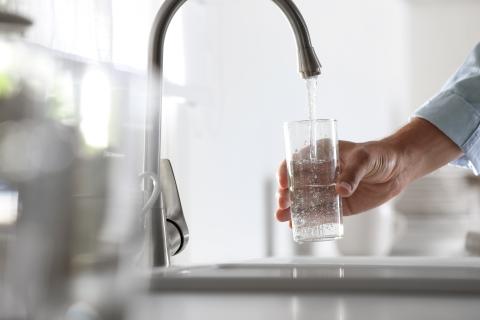Drinking Water: Bacteria
What are bacteria?
Bacteria are living things that are made up of only one cell. There are many types of bacteria that are naturally found in the environment and can get into drinking water.
Bacteria testing looks for signs that the private well can be affected by harmful bacteria. These most common signs are used for are total coliform bacteria and Escherichia coli (E. coli) bacteria.
- When total coliform bacteria are found, the well is at risk for more serious forms of contamination.
- When E. coli bacteria are found, the well may be contaminated with human or animal waste.
How can I be exposed to bacteria?
Bacteria can get into well water when work is done on it, if it was not built properly, or if there are nearby sources of animal or human waste.
How can bacteria affect my health?
While most bacteria do not affect our health, some bacteria can make us sick. These bacteria can cause flu-like illnesses, leading to diarrhea, nausea, vomiting, cramps, or fever.
Young children, people with weakened immune systems, and the elderly are at the greatest risk.
Talk to your health care professional if you or a family member have symptoms that you believe are related to your drinking water.
How can I protect myself and my family from bacteria?
Public water systems issue boil water notices if bacteria are detected or if system is at risk for bacteria contamination due to a water main break or construction work.
When a boil water notice is issued,
- Use an alternative source of water for drinking, rinsing fruits and vegetables, brushing teeth, and bathing babies.
- Options for alternative sources water that you boiled for one minute, bottled water, and water from a public system without violations.
- Throw out ice and drinks made with the water.
- Use your dishwasher’s heated dry or sanitize cycle or wash by hand with a sanitizing solution.
- Talk to your doctor if you or a family member has systems that you think may be from your water.
Our How to Keep Safe if You Receive a Boil Water Notice fact sheet, P-44589 (PDF) has more detail on these steps in printable format.
Private well users should test for bacteria at least once a year using a Wisconsin certified lab.
- Test right away if you notice a change in the color, taste, or smell of your water.
Take action if bacteria are present.
- Immediately start using an alternative source of water for for drinking, rinsing fruits and vegetables, brushing teeth, and bathing babies.
Options for alternative sources water that you boiled for one minute, include include bottled water, water from a well without issues, and water from a public system without violations.
- Take additional protective measures:
- Throw out ice and drinks made with the water.
- Use your dishwasher’s heated dry or sanitize cycle or wash by hand with a sanitizing solution.
- Be careful while bathing and make sure kids do not swallow the water.
- Retest your well to verify to results.
- If bacteria are still present:
- Continue using an alternative source of water drinking, rinsing fruits and vegetables, brushing teeth, and bathing babies.
- Work with a licensed professional to disinfect your well and address the source of contamination.
- Test again to make sure the disinfection worked.
If the disinfection did not work, consider replacing the well or installing a certified treatment device.
DNR's well compensation grants provide funds to help address contamination in private wells.
Our Bacteria in Private Wells fact sheet, P-02132 has these steps in printable format.
Who regulates bacteria in Wisconsin?
Bacteria are naturally occurring in the environment and are a natural part of human and animal waste. The Department of Natural Resources regulates direct releases of bacteria into surface water and groundwater.
The DNR also regulates how much bacteria can be in water served by public water systems and establishes environmental requirements to control runoff from fields, pastures and livestock facilities.
Related topics
DNR's bacteria in wells brochure has information on sources and follow-up steps.
Our groundwater standards page has information on how Wisconsin's groundwater standards are set, the Department of Health Service's role in the process, and a summary of the current and recommended standards including bacteria.
DHS' and DNR's Tests for Private Well Users fact sheet has information on other common contaminants that well users should test for regularly.
The Wisconsin Groundwater Coordinating Council's annual report summarizes the operations and activities occurring within the state to address groundwater issues including bacteria.
The UW-Steven Point's Well Water Quality Interactive Viewer shows water quality data from a variety of contaminants (including bacteria) at a county, township, and section levels.
Questions?
Can't find what you're looking for? Contact us at dhsenvhealth@dhs.wisconsin.gov.

